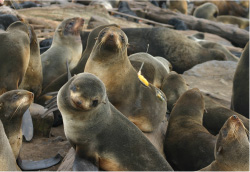Our high tides, salty air and rocky coasts are just a few of the things that distinguish Nova Scotia — and HÂţ» University — from other places in Canada. From commercial fishing to tourism to the beauty and serenity enjoyed along 74,000 kilometres of coastline, the ocean has a powerful presence here; one that’s sure to make an impression.
It was only natural for this year’s Homecoming lecture to highlight what marine animal tracking initiatives at Dal can teach us about oceans and ocean climate change.
“Oceans make up more than 70 per cent of the earth’s surface and represent a huge resource that we’ve depended on for centuries,” said Biology Professor Sara Iverson.
Dr. Iverson is the scientific director of the Ocean Tracking Network (OTN), a global infrastructure and research network and “international ocean observatory,” headquartered at HÂţ». The audience was attentive as she outlined issues affecting our oceans, including depletion of fish stocks and other marine species, habitat destruction, pollution, and climate change.
New ways to study marine species
 “The question I and my colleagues are interested in is how all these trends influence species distribution and abundance, migration patterns, and survival . . . And how can we better understand, conserve, manage and possibly reverse the disastrous trends that are occurring,” she explained.
“The question I and my colleagues are interested in is how all these trends influence species distribution and abundance, migration patterns, and survival . . . And how can we better understand, conserve, manage and possibly reverse the disastrous trends that are occurring,” she explained.
Dr. Iverson discussed traditional methods for studying marine species and outlined the limitations those methods face. She then highlighted new and powerful tracking projects, which are part of OTN and beyond. These included a sturgeon tracking study in the Saint John River, an eel tracking study through the St. Lawrence system, polar bear studies across the Arctic, fur seal studies in the Bering Sea and, finally, grey seal studies on Sable Island.
The studies bring to light behavioural patterns that have never before been discovered.
The endangered eels, for example, didn’t make it to their annual spawning location in the Sargasso Sea during one year of their study. But it took the data collected from their tags to explain why.
“We determined a newly discovered and large predation pressure by sharks — we think porbeagle,” explained Dr. Iverson. “This was determined by the archived tag temperatures recovered after they’d been processed by the shark. It had to be an endothermic tuna or shark — and it was determined by the vertical profile that it must be sharks.”
Catching up with new developments
Dr. Iverson concluded by emphasizing that the need to understand and better manage and conserve our oceans and the animals that inhabit them has never been greater, and that we now have tools with which to do so.
Dal Biology alumnus (1970) Garry Ross made sure he caught the lecture while he was visiting from Ottawa.
“It’s fascinating, the way they’ve co-opted the animals to do the work for them,” he laughed. “I just wanted to catch up with where the sciences have moved to. I’m no oceanographer by any means, but clearly it’s biologically related, and it was just an opportunity to find out where sciences have moved in the last 30-40 years.”

